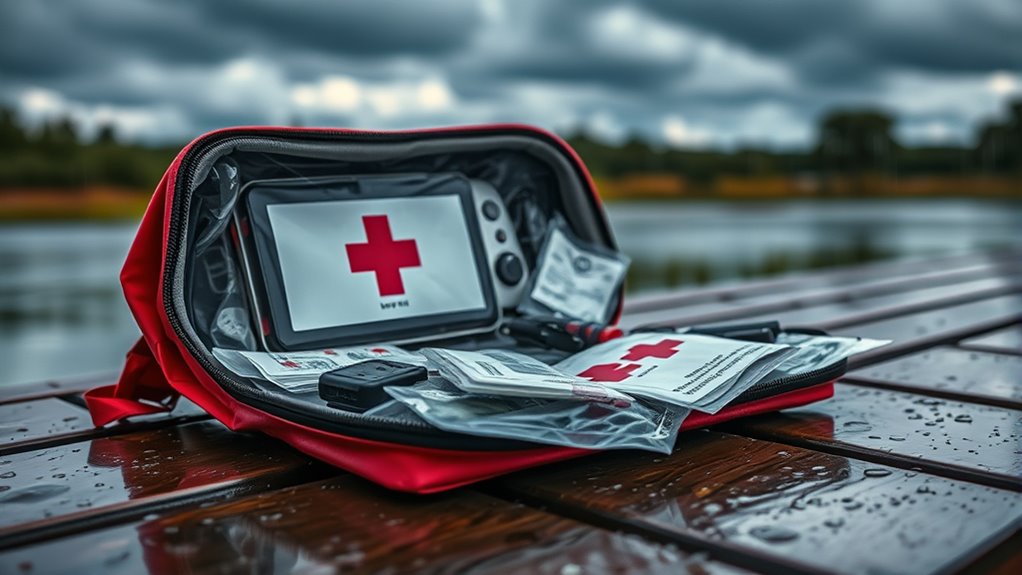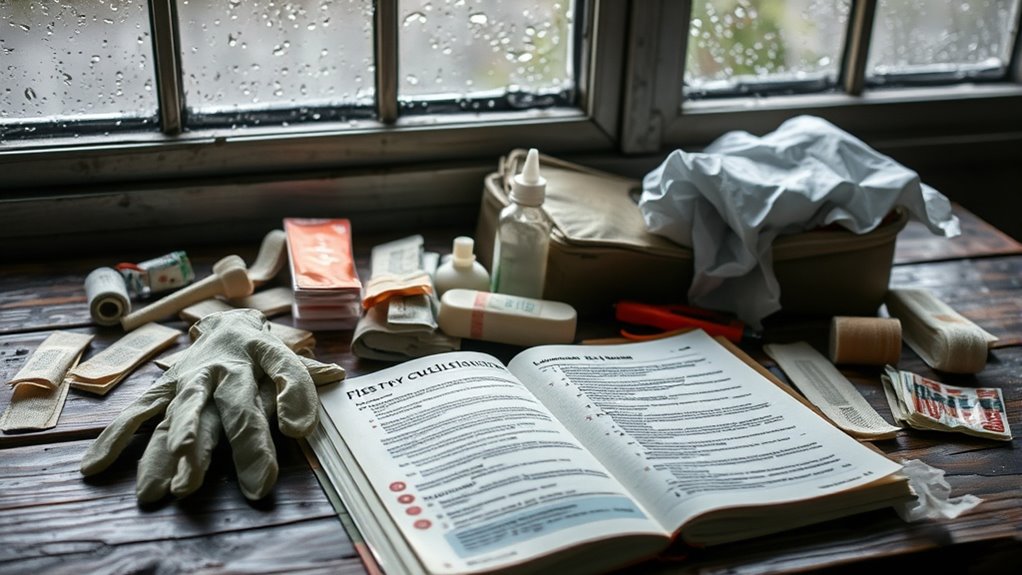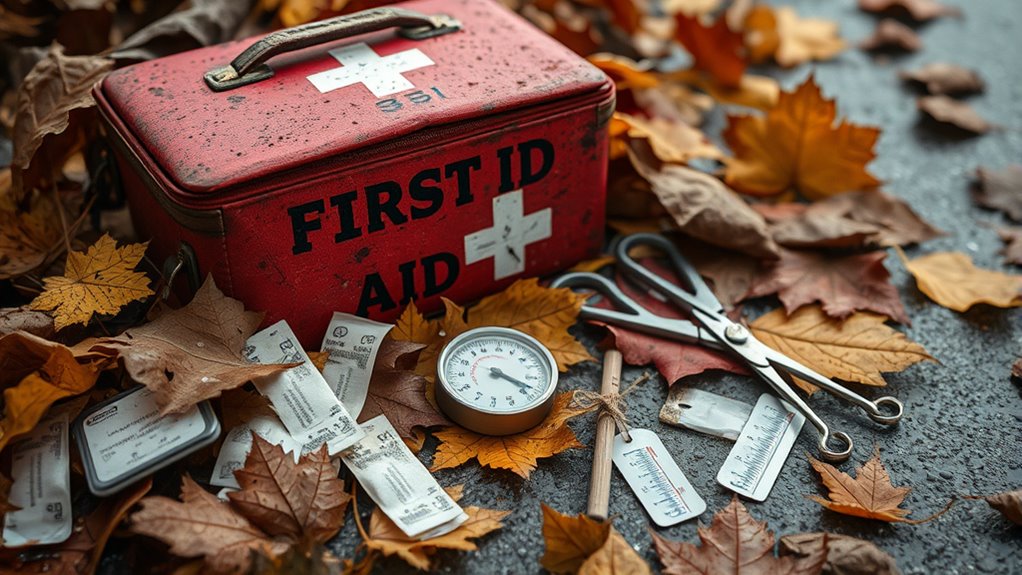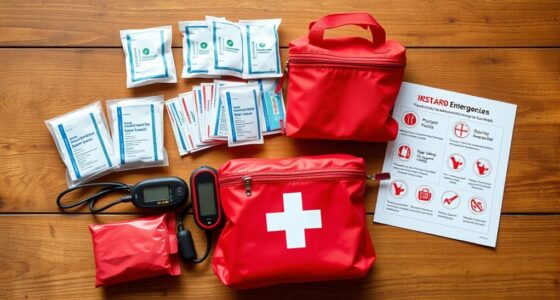Investing in advanced first aid gear for storms may seem wise, but hidden costs can catch you off guard. High equipment prices, ongoing maintenance, and potential over-treatment can strain your budget and cause health risks. Using techniques you’re not skilled in increases the chance of errors and costly mistakes. To avoid these pitfalls, focus on affordable, essential supplies and proper training. Continue to explore how smart planning can keep you safe without overspending.
Key Takeaways
- Advanced gear and training can be costly; prioritize essential, budget-friendly supplies for effective storm preparedness.
- Over-treating minor injuries with advanced tools may waste resources and delay recovery; focus on basic care.
- Improper technique or lack of knowledge increases risk of harm, leading to costly mistakes; seek proper training and updates.
- Regular maintenance of advanced equipment prevents failures during emergencies, avoiding costly repairs or replacements.
- Use cost-effective, proven first aid methods and avoid unnecessary advanced procedures to minimize financial and health risks.
The Hidden Expenses of Specialized Equipment

While specialized equipment can be essential during storms, it often comes with hidden costs that catch many people off guard. Equipment expenses can add up quickly, especially if you feel the need to buy the latest or most advanced gear. Beyond the initial purchase, gear maintenance becomes an ongoing responsibility, requiring regular cleaning, repairs, and replacements to keep equipment effective. Neglecting maintenance can lead to equipment failure when you need it most, risking safety. It’s tempting to invest in high-end tools, but often, basic first aid supplies can handle most emergencies without the hefty price tag. By understanding the true costs of equipment expenses and committing to proper gear maintenance, you can stay prepared and avoid unnecessary financial strain during storm situations. Additionally, understanding well-being tips can help you stay calm and focused in emergency scenarios, ensuring better decision-making and safety.
Risks of Over-Treatment and Unnecessary Procedures

Investing in first aid supplies is important, but it’s just as vital to use them wisely. Over-treatment pitfalls can lead to unnecessary procedures that may harm more than help. Here are three risks to watch for:
- Worsening the injury: Unnecessary cleaning or excessive bandaging can cause pain or delay healing.
- Introducing infection: Overly aggressive cleaning or using unneeded antibiotics increases infection risk.
- Wasting resources: Using supplies for minor issues leads to shortages when real emergencies happen.
- Additionally, improper application of advanced first aid techniques can compromise color accuracy and hinder recovery efforts.
Costly Mistakes From Improper Technique or Knowledge Gaps

Many costly mistakes in first aid happen because people lack proper technique or knowledge. One common error is medication misuse, such as giving the wrong dose or administering medication without proper assessment. This can worsen the victim’s condition or cause adverse reactions. Additionally, improper techniques—like incorrect bandaging or CPR—may fail to help or cause further injury. These mistakes also lead to liability concerns; providing improper care could result in legal issues if the victim experiences harm. Without proper training, you risk misjudging situations or acting beyond your scope, increasing the chance of costly errors. To avoid these pitfalls, make sure you’re well-informed and confident in your skills, always following current guidelines and recognizing your limits to prevent unintentional harm.
Strategies to Maximize Safety Without Breaking the Bank

You can enhance your safety during storms without overspending by focusing on practical, cost-effective strategies. Start with affordable supplies—look for basic first aid kits that provide essential items without extra costs. Next, prioritize cost-effective training; many community centers or online resources offer free or low-cost courses to boost your skills. Finally, regularly practice your skills to ensure readiness, which doesn’t guarantee additional spending but maximizes your preparedness. Additionally, utilizing cost-effective skincare ingredients like glycolic acid can support your skin health, especially when exposed to harsh weather conditions, helping you maintain a resilient barrier against environmental stressors.
Frequently Asked Questions
Are There Affordable Alternatives to Specialized Advanced First Aid Gear?
Yes, there are budget options and gear alternatives for advanced first aid. You can find affordable basic supplies like bandages, antiseptics, and splints at drugstores or online retailers. Consider repurposing household items, such as using clean cloths as dressings or ice packs made from frozen gel-filled bags. These alternatives help you build a cost-effective first aid kit without sacrificing essential preparedness for storm emergencies.
How Can I Identify When Advanced Procedures Are Truly Necessary?
You can identify when advanced procedures are necessary by performing a quick risk assessment and recognizing key symptoms. Look for severe bleeding, difficulty breathing, loss of consciousness, or signs of shock, which indicate urgent needs. Trust your training to evaluate the situation carefully. If symptoms worsen or don’t improve, don’t hesitate to seek professional help. Acting promptly based on symptom recognition and risk assessment can prevent complications.
What Common Mistakes Lead to Increased Costs During Storm First Aid?
Imagine rushing into storm chaos, but mistakes like misusing equipment or delaying response can turn chaos into costly ruin. You might misuse equipment, causing damage or needing replacements, or delay administering aid, worsening injuries—both skyrocketing costs. These errors drain resources and extend recovery. Stay alert, follow proper procedures, and respond promptly to avoid these pitfalls, saving both lives and money during storm emergencies.
How Do I Ensure Proper Technique Without Formal Medical Training?
To guarantee proper technique without formal medical training, consider getting CPR certification and studying wound management guides. Practice regularly with a first aid kit to build confidence and familiarity. Use online tutorials and trusted resources to learn step-by-step procedures. Remember, staying calm and focused helps you perform skills correctly, reducing risks and preventing hidden costs. Continuous learning and practice are key to effectively handling storm-related injuries.
Can Basic First Aid Skills Reduce the Need for Costly Advanced Interventions?
Sure, mastering basic skills can cut costs, but don’t get complacent—pretending you’re a hero with a bandage isn’t a substitute for professional care. Your basic first aid skills can handle minor injuries, reducing the need for costly advanced interventions. Not only does this save money, but it also keeps you prepared for emergencies. So, sharpen those skills; it’s a smart move to avoid unnecessary expenses and chaos.
Conclusion
By understanding these hidden costs, you can avoid turning your first aid kit into a financial black hole. Don’t let unnecessary equipment, over-treatment, or mistakes drain your resources faster than a storm surge floods the coast. With smart choices and proper training, you’ll navigate storm emergencies confidently—proving that being prepared doesn’t have to break the bank. Stay informed, stay safe, and keep your first aid efforts as efficient as a well-oiled rescue operation.









